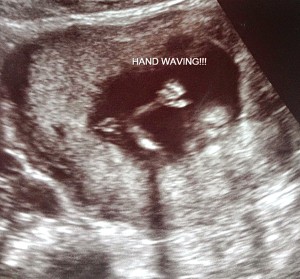My First Trimester
Week 12
Estimated Reading Time: 4 minutes You’ve reached the end of your first trimester. Not only is your baby growing fingernails and toenails but your baby now exhibits a human profile as both the nose and chin are well defined. Vocal cords are present but due to the lack of air existing in your baby’s environment to make vibrations, the baby’s cords most likely do not make any sounds. The heartbeat can probably be detected now by your health care team using a Fetal Doppler ultrasound. Lengthwise, your baby is measuring about 2½ inches in length, the size of an apricot. Your baby weighs half an ounce now.
You’ve reached the end of your first trimester. Not only is your baby growing fingernails and toenails but your baby now exhibits a human profile as both the nose and chin are well defined. Vocal cords are present but due to the lack of air existing in your baby’s environment to make vibrations, the baby’s cords most likely do not make any sounds. The heartbeat can probably be detected now by your health care team using a Fetal Doppler ultrasound. Lengthwise, your baby is measuring about 2½ inches in length, the size of an apricot. Your baby weighs half an ounce now.
Chorionic Villus Sampling (CVS) and Amniocentesis
 If you are over 35, have a family history of a genetic disorder, or have had a chromosomal abnormality in a previous pregnancy, you may want to consider having a Chorionic Villus Sampling (CVS). This is an invasive diagnostic test performed by sampling the chorionic villus from the placenta. These villi, which actually form the placenta and share the baby’s genetics, were first seen developing in Week 6.
If you are over 35, have a family history of a genetic disorder, or have had a chromosomal abnormality in a previous pregnancy, you may want to consider having a Chorionic Villus Sampling (CVS). This is an invasive diagnostic test performed by sampling the chorionic villus from the placenta. These villi, which actually form the placenta and share the baby’s genetics, were first seen developing in Week 6.
This testing will reveal genetic disorders such as Tay-Sachs disease, Cystic Fibrosis or a chromosomal abnormality such as Down syndrome. It will not test for neural tube defects such as spina bifida. You should discuss with your health care team the decision of whether or not to have this test done. Although this sampling will provide important information regarding your baby’s health, its risks must be clearly explained and disclosed. CVS can be performed earlier than an amniocentesis and the results will be available sooner. This early test usually performed during Weeks 11-13 will put your fears to rest sooner, and provide more time to plan and prepare for your child’s condition.
An amniocentesis, usually done between Weeks 15-20, is a test to check for fetal abnormalities such as Down syndrome, a genetic disorder, or spinal bifida, a neural tube defect, and has been a valuable tool in assessing fetal well-being since the 1970s. If you are at a particular risk for either one of these conditions, you can postpone having an amniocentesis until after you’ve seen the results of your second trimester screenings. An amniocentesis removes about 2 Tbsp. (30 ml.) of the amniotic fluid surrounding your baby for testing. This analysis may be a better choice over CVS if the results of other blood tests (such as the alpha-fetoprotein test) taken during your pregnancy have been abnormal. An amniocentesis may also be ordered during the third trimester of your pregnancy to confirm fetal lung maturity if your doctor is considering an early delivery.
Both tests, when performed before Week 20, carry the following risk of miscarriage: one in 200. CVS could introduce GBS into the uterine cavity and amniocentesis could make a point of entry into the placenta for GBS. Please discuss the risks with your care provider before undergoing either of these procedures. For more information on CVS or amniocentesis, visit MedlinePlus, a service of the U.S. National Library of Medicine, National Institutes of Health.
There is a new genetic maternity blood test, the MaterniT21™PLUS, which can be performed earlier than a CVS or an amniocentesis. With no threat of miscarriage, this test may be drawn as early as Week 10. The results will determine if your baby is at risk for various genetic anomalies such as Down syndrome or Trisomy 18. Although it doesn’t rule out all genetic abnormalities, it is noninvasive, carries a high accuracy rate (99.1%), a low false positive rate (0.2%), and lets you know the sex of your baby. Early testing allows extra time to ask questions, schedule further tests, make an appointment with a maternal fetal specialist or perinatologist, and most importantly, more time to prepare and plan if a genetic abnormality is found. Speak with your health care team about this new approach if genetic testing is recommended.